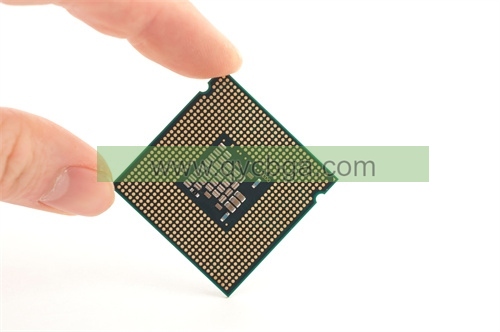ผู้ผลิต PCB วัสดุ Megtron7
ผู้ผลิต PCB วัสดุ Megtron7,เม็กตรอน 7 วัสดุ PCB แสดงถึงระดับแนวหน้าของแผงวงจรพิมพ์ (PCB) เทคโนโลยี. ผลิตโดย Panasonic Corporation, วัสดุประสิทธิภาพสูงนี้มีชื่อเสียงในด้านคุณสมบัติทางไฟฟ้าที่โดดเด่น, เสถียรภาพทางความร้อน, และความน่าเชื่อถือทางกล. เม็กตรอน 7 วัสดุมีค่าคงที่ไดอิเล็กทริกต่ําและปัจจัยการกระจายต่ํา, ทําให้เหมาะสําหรับการใช้งานความถี่สูง เช่น อุปกรณ์สื่อสาร, อุปกรณ์เครือข่าย, และระบบคอมพิวเตอร์ประสิทธิภาพสูง. เสถียรภาพทางความร้อนและความแข็งแรงเชิงกลที่ยอดเยี่ยมยังทําให้เป็นเลิศในสภาพแวดล้อมที่มีความต้องการสูง เช่น ยานยนต์ อิเล็กทรอนิกส์ และระบบการบินและอวกาศ. การออกแบบ Megtron 7 PCB ต้องการการพิจารณา เช่น หลักการออกแบบความถี่สูง, การจัดการความร้อน, และการออกแบบเครื่องกล, ในขณะที่กระบวนการผลิตที่เข้มงวดช่วยให้มั่นใจได้ถึงคุณภาพและความน่าเชื่อถือ. แม้จะมีต้นทุนที่อาจสูงกว่าเมื่อเทียบกับ FR-4 PCB แบบดั้งเดิม, ประสิทธิภาพและความน่าเชื่อถือที่เหนือกว่าของ Megtron 7 PCB ทําให้เป็นตัวเลือกที่ต้องการสําหรับการใช้งานอิเล็กทรอนิกส์ระดับไฮเอนด์.
PCB วัสดุ Megtron7 คืออะไร?
เม็กตรอน 7 เป็นวัสดุประสิทธิภาพสูงชนิดหนึ่งที่ใช้ในการผลิตแผงวงจรพิมพ์ (PCB). PCB เป็นส่วนประกอบสําคัญในอุปกรณ์อิเล็กทรอนิกส์, ทําหน้าที่เป็นรากฐานในการเชื่อมต่อและรองรับชิ้นส่วนอิเล็กทรอนิกส์ต่างๆ. เม็กตรอน 7 วัสดุมีข้อดีหลายประการเหนือวัสดุ PCB แบบดั้งเดิม, ทําให้เป็นตัวเลือกยอดนิยมสําหรับการใช้งานที่มีความต้องการสูง.
หนึ่งในคุณสมบัติหลักของ Megtron 7 คือประสิทธิภาพความถี่สูง. วัสดุนี้มีคุณสมบัติความสมบูรณ์ของสัญญาณที่ดีเยี่ยม, ช่วยให้สามารถส่งสัญญาณความถี่สูงได้อย่างมีประสิทธิภาพโดยไม่สูญเสียหรือบิดเบือนอย่างมีนัยสําคัญ. สิ่งนี้ทําให้ Megtron 7 เหมาะอย่างยิ่งสําหรับการใช้งานที่ต้องการการส่งข้อมูลความเร็วสูง, เช่น อุปกรณ์โทรคมนาคม, อุปกรณ์เครือข่าย, และระบบคอมพิวเตอร์ประสิทธิภาพสูง.
นอกจากประสิทธิภาพความถี่สูงแล้ว, เม็กตรอน 7 นอกจากนี้ยังมีเสถียรภาพทางความร้อนที่น่าประทับใจ. อุปกรณ์อิเล็กทรอนิกส์สร้างความร้อนระหว่างการทํางาน, และความร้อนที่มากเกินไปสามารถลดประสิทธิภาพและความน่าเชื่อถือของ PCB. เม็กตรอน 7 วัสดุมีค่าสัมประสิทธิ์การขยายตัวทางความร้อนต่ํา (ซีทีอี), หมายความว่าสามารถทนต่อความผันผวนของอุณหภูมิได้โดยไม่ประสบกับการเปลี่ยนแปลงมิติอย่างมีนัยสําคัญ. สิ่งนี้ทําให้ Megtron 7 เหมาะสําหรับใช้ในสภาพแวดล้อมที่มีสภาวะความร้อนที่ท้าทาย, เช่น ยานยนต์ อิเล็กทรอนิกส์ และระบบการบินและอวกาศ.
อนึ่ง, เม็กตรอน 7 แสดงคุณสมบัติทางกลที่ดีเยี่ยม, รวมถึงความต้านทานแรงดึงและความแข็งแกร่งสูง. สิ่งนี้ทําให้มั่นใจได้ว่า PCB ที่ผลิตโดยใช้ Megtron 7 วัสดุมีความแข็งแรงและทนทาน, สามารถทนต่อความเครียดเชิงกล เช่น การสั่นสะเทือนและแรงกระแทก. ส่งผลให้, เม็กตรอน 7 PCB เหมาะอย่างยิ่งสําหรับการใช้งานที่ความน่าเชื่อถือเป็นสิ่งสําคัญยิ่ง, เช่น ระบบควบคุมอุตสาหกรรมและอุปกรณ์ทางการแพทย์.
ทั้งหมด, เม็กตรอน 7 วัสดุ PCB นําเสนอการผสมผสานที่น่าสนใจของประสิทธิภาพความถี่สูง, เสถียรภาพทางความร้อน, และความทนทานทางกล, ทําให้เป็นตัวเลือกที่ต้องการสําหรับการใช้งานอิเล็กทรอนิกส์ขั้นสูงที่หลากหลาย. ในขณะที่เม็กตรอน 7 อาจมีค่าใช้จ่ายสูงกว่าเมื่อเทียบกับวัสดุ PCB มาตรฐาน, ประสิทธิภาพและความน่าเชื่อถือที่เหนือกว่าแสดงให้เห็นถึงการลงทุนสําหรับระบบที่สําคัญต่อภารกิจซึ่งประสิทธิภาพและอายุการใช้งานยาวนานเป็นสิ่งสําคัญ.

ผู้ผลิต PCB วัสดุ Megtron7
แนวทางการออกแบบ PCB วัสดุ Megtron7 คืออะไร?
เม็กตรอน 7 วัสดุ PCB แนวทางการออกแบบเป็นสิ่งสําคัญสําหรับการรับรองประสิทธิภาพและความน่าเชื่อถือสูงสุดของแผงวงจรพิมพ์. ต่อไปนี้คือข้อควรพิจารณาและแนวทางการออกแบบที่สําคัญสําหรับการทํางานกับ Megtron 7 วัตถุ:
- ข้อควรพิจารณาในการออกแบบความถี่สูง: เม็กตรอน 7 เป็นที่รู้จักในด้านประสิทธิภาพความถี่สูงที่ยอดเยี่ยม. นักออกแบบควรใส่ใจกับการจับคู่อิมพีแดนซ์, ร่องรอยอิมพีแดนซ์ที่ควบคุมได้, และหลักการความสมบูรณ์ของสัญญาณเพื่อลดการสูญเสียและการบิดเบือนของสัญญาณ, โดยเฉพาะอย่างยิ่งในการใช้งานการส่งข้อมูลความเร็วสูง.
- การจัดการความร้อน: แม้จะมีเสถียรภาพทางความร้อนสูง, การจัดการความร้อนที่เหมาะสมยังคงเป็นสิ่งสําคัญ. ตรวจสอบให้แน่ใจว่ามีระยะห่างระหว่างส่วนประกอบที่เพียงพอเพื่อให้การไหลเวียนของอากาศและการกระจายความร้อนที่เหมาะสม. พิจารณารวมจุดแวะระบายความร้อนเพื่อถ่ายเทความร้อนออกจากส่วนประกอบที่สําคัญอย่างมีประสิทธิภาพและกระจายไปทั่วทั้ง PCB.
- การออกแบบเครื่องกล: เม็กตรอน 7 มีคุณสมบัติเชิงกลที่แข็งแกร่ง, แต่นักออกแบบควรปฏิบัติตามแนวทางปฏิบัติที่ดีที่สุดสําหรับการออกแบบเครื่องกล. ซึ่งรวมถึงการลดความเข้มข้นของความเครียด, ให้การสนับสนุนที่เพียงพอสําหรับส่วนประกอบที่มีน้ําหนักมาก, และให้แน่ใจว่ามีระยะห่างเพียงพอสําหรับขั้วต่อและฮาร์ดแวร์สําหรับติดตั้ง.
- การออกแบบ Stackup: เพิ่มประสิทธิภาพการซ้อนทับ PCB เพื่อใช้ประโยชน์จากคุณสมบัติของ Megtron 7. พิจารณาใช้หลายชั้นสําหรับการควบคุมอิมพีแดนซ์และการกําหนดเส้นทางสัญญาณ, ด้วยความหนาของอิเล็กทริกและน้ําหนักทองแดงที่เหมาะสมเพื่อตอบสนองความต้องการในการออกแบบ.
- ข้อจํากัดในการผลิต: คํานึงถึงข้อจํากัดในการผลิตที่เกี่ยวข้องกับ Megtron 7 วัตถุ. ปรึกษากับพันธมิตรด้านการผลิต PCB ของคุณเพื่อให้แน่ใจว่าการออกแบบของคุณเป็นไปตามความสามารถและข้อจํากัดของพวกเขา, เช่นความกว้างและระยะห่างของร่องรอยขั้นต่ํา, ขนาดดอกสว่านขั้นต่ํา, และข้อจํากัดอัตราส่วนภาพสําหรับจุดผ่านการชุบ.
- ข้อควรพิจารณาด้านสิ่งแวดล้อม: พิจารณาสภาพแวดล้อมการทํางานของ PCB เมื่อออกแบบด้วย Megtron 7 วัตถุ. ตรวจสอบให้แน่ใจว่าคณะกรรมการเป็นไปตามมาตรฐานและข้อกําหนดด้านสิ่งแวดล้อมที่เกี่ยวข้อง, เช่นอุณหภูมิ, ความชื้น, และการสัมผัสสารเคมี.
- การวิเคราะห์ความสมบูรณ์ของสัญญาณ: ทําการวิเคราะห์ความสมบูรณ์ของสัญญาณอย่างละเอียดโดยใช้เครื่องมือจําลองเพื่อตรวจสอบการออกแบบและระบุปัญหาที่อาจเกิดขึ้น เช่น อิมพีแดนซ์ไม่ตรงกัน, ครอสทอล์ค, และการสะท้อนสัญญาณ. ปรับการออกแบบตามต้องการเพื่อเพิ่มความสมบูรณ์ของสัญญาณและลดสัญญาณรบกวน.
- เอกสารและการสื่อสาร:จัดทําเอกสารแนวทางและข้อกําหนดการออกแบบอย่างชัดเจนและสื่อสารกับผู้มีส่วนได้ส่วนเสียอย่างมีประสิทธิภาพ, รวมถึงนักออกแบบ PCB, ผู้ผลิต, และพันธมิตรการประกอบ. การสื่อสารที่ชัดเจนช่วยให้มั่นใจได้ว่าทุกคนที่เกี่ยวข้องเข้าใจข้อกําหนดและวัตถุประสงค์ของการออกแบบ.
โดยปฏิบัติตามแนวทางการออกแบบและแนวทางปฏิบัติที่ดีที่สุดเหล่านี้, นักออกแบบสามารถเพิ่มประสิทธิภาพและความน่าเชื่อถือของ PCB ได้โดยใช้ Megtron 7 วัตถุ, มั่นใจได้ว่าตรงตามความต้องการของการใช้งานอิเล็กทรอนิกส์สมัยใหม่.
กระบวนการผลิต PCB วัสดุ Megtron7 คืออะไร?
กระบวนการผลิตสําหรับ เม็กตรอน 7 วัสดุ PCBs ทําตามขั้นตอนที่คล้ายคลึงกับการผลิต PCB แบบดั้งเดิม แต่มีการพิจารณาเฉพาะสําหรับคุณสมบัติเฉพาะของ Megtron 7 วัตถุ. นี่คือภาพรวมของกระบวนการผลิต:
- การเลือกวัสดุ: กระบวนการผลิตเริ่มต้นด้วยการเลือก Megtron ที่เหมาะสม 7 วัสดุลามิเนตสําหรับ PCB. เม็กตรอน 7 เป็นวัสดุประสิทธิภาพสูงที่มีคุณสมบัติเฉพาะที่ปรับให้เหมาะกับการใช้งานความถี่สูง, ดังนั้นการเลือกเกรดและความหนาของวัสดุที่เหมาะสมจึงเป็นสิ่งสําคัญ.
- การเตรียมพื้นผิว: เม็กตรอน 7 แผ่นลามิเนตถูกตัดตามขนาดที่ต้องการและทําความสะอาดเพื่อขจัดสิ่งปนเปื้อนที่อาจส่งผลต่อกระบวนการยึดติด.
- การออกแบบวงจร: นักออกแบบ PCB สร้างเค้าโครงวงจรโดยใช้ซอฟต์แวร์ CAD, โดยคํานึงถึงข้อกําหนดการออกแบบเฉพาะและข้อจํากัดของแอปพลิเคชัน. ใช้หลักการออกแบบความถี่สูงเพื่อให้แน่ใจว่าความสมบูรณ์ของสัญญาณและการควบคุมอิมพีแดนซ์.
- การออกแบบเลเยอร์ Stackup: การซ้อนเลเยอร์ได้รับการออกแบบมาเพื่อเพิ่มประสิทธิภาพการกําหนดเส้นทางสัญญาณ, การจับคู่อิมพีแดนซ์, และการจัดการความร้อน. สิ่งนี้เกี่ยวข้องกับการกําหนดจํานวนเลเยอร์, การจัดเรียงระนาบสัญญาณและกราวด์, และความหนาของชั้นอิเล็กทริก.
- เคลือบ: แต่ละชั้นของ Megtron 7 ลามิ เนต, พร้อมกับฟอยล์ทองแดงสําหรับร่องรอยที่เป็นสื่อกระแสไฟฟ้า, เคลือบเข้าด้วยกันภายใต้ความร้อนและความดันเพื่อสร้างโครงสร้างหลายชั้นเดียว. กระบวนการนี้ช่วยให้มั่นใจได้ถึงการยึดเกาะที่แข็งแกร่งระหว่างชั้นและสร้างการซ้อนทับของชั้นที่ต้องการ.
- เจาะ:หลังจากเคลือบ, เจาะรูที่มีความแม่นยําใน PCB ในตําแหน่งที่ระบุโดยการออกแบบ, โดยทั่วไปจะใช้เครื่องเจาะที่ควบคุมด้วยคอมพิวเตอร์. รูเหล่านี้จะใช้สําหรับการติดตั้งส่วนประกอบและการเชื่อมต่อโครงข่ายผ่านจุดแวะชุบในภายหลัง.
- ชุบทองแดง: ทองแดงถูกชุบด้วยไฟฟ้าบนพื้นผิวของ PCB และภายในรูที่เจาะเพื่อสร้างเส้นทางนําไฟฟ้าระหว่างชั้น. ความหนาของทองแดงถูกควบคุมให้เป็นไปตามข้อกําหนดการออกแบบสําหรับอิมพีแดนซ์การติดตามและความสามารถในการรับกระแสไฟฟ้า.
- การแกะสลักและการถ่ายภาพ: ชั้นโฟโตรีซิสต์ถูกนําไปใช้กับพื้นผิวทองแดง, และ PCB สัมผัสกับแสงยูวีผ่านโฟโตมาสก์เพื่อถ่ายโอนรูปแบบวงจรไปยังโฟโตรีซิสต์. จากนั้นบริเวณที่สัมผัสจะถูกแกะสลักออกโดยใช้กระบวนการทางเคมี, ทิ้งร่องรอยทองแดงที่ต้องการไว้เบื้องหลัง.
- เสร็จสิ้นพื้นผิว: พื้นผิว PCB เสร็จสิ้นเพื่อป้องกันร่องรอยทองแดงจากการเกิดออกซิเดชันและอํานวยความสะดวกในการบัดกรีระหว่างการประกอบ. พื้นผิวทั่วไปสําหรับ Megtron 7 PCB รวมถึง ENIG (นิกเกิลแช่ทองแบบไม่ใช้ไฟฟ้า), OSP (สารกันบูดความสามารถในการบัดกรีอินทรีย์), และดีบุกแช่.
- การควบคุมคุณภาพและการทดสอบ: PCB สําเร็จรูปผ่านการควบคุมคุณภาพและการทดสอบอย่างเข้มงวดเพื่อให้แน่ใจว่าเป็นไปตามข้อกําหนดที่จําเป็นสําหรับความแม่นยําของมิติ, ประสิทธิภาพทางไฟฟ้า, และความน่าเชื่อถือ. ซึ่งอาจรวมถึงการตรวจสอบด้วยสายตา, การทดสอบทางไฟฟ้า, และการทดสอบด้านสิ่งแวดล้อม.
- การกําหนดเส้นทางและการทําโปรไฟล์: ในที่สุด, PCB แต่ละตัวจะถูกกําหนดเส้นทางออกจากแผงขนาดใหญ่และทําโปรไฟล์เป็นขนาดสุดท้ายโดยใช้เครื่องกัด CNC หรือเราเตอร์เชิงกล.
ทั้งหมด, กระบวนการผลิต Megtron 7 วัสดุ PCB ต้องการความใส่ใจในรายละเอียดอย่างรอบคอบและการปฏิบัติตามมาตรฐานคุณภาพสูงเพื่อให้มั่นใจถึงประสิทธิภาพและความน่าเชื่อถือสูงสุดในการใช้งานอิเล็กทรอนิกส์ความถี่สูง. ความร่วมมือระหว่างนักออกแบบ PCB, ผู้ผลิต, และผู้ผลิตเป็นสิ่งสําคัญในการประดิษฐ์และประกอบ Megtron ให้ประสบความสําเร็จ 7 PCB ที่ตอบสนองความต้องการของระบบอิเล็กทรอนิกส์สมัยใหม่.
คุณจะผลิต PCB วัสดุ Megtron7 ได้อย่างไร?
การผลิต PCB ด้วย Megtron 7 วัสดุมีหลายขั้นตอน, แต่ละอย่างมีความสําคัญเพื่อให้แน่ใจว่าผลิตภัณฑ์ขั้นสุดท้ายตรงตามข้อกําหนดที่ต้องการสําหรับประสิทธิภาพและความน่าเชื่อถือ. นี่คือภาพรวมของกระบวนการผลิต:
- การเตรียมวัสดุ: กระบวนการเริ่มต้นด้วยการเตรียม Megtron 7 วัสดุลามิเนต. แผ่นของ Megtron 7 ถูกตัดให้ได้ขนาดที่ต้องการตามข้อกําหนดการออกแบบ PCB. สิ่งสําคัญคือต้องจัดการวัสดุอย่างระมัดระวังเพื่อป้องกันความเสียหายหรือการปนเปื้อน.
- การออกแบบเลเยอร์ Stackup: การซ้อนชั้นได้รับการออกแบบมาเพื่อตอบสนองความต้องการเฉพาะของการออกแบบ PCB, รวมถึงการกําหนดเส้นทางสัญญาณ, การควบคุมอิมพีแดนซ์, และการจัดการความร้อน. จํานวนและการจัดเรียงของเลเยอร์, เช่นเดียวกับความหนาของชั้นอิเล็กทริก, มุ่งมั่นที่จะเพิ่มประสิทธิภาพ.
- Prepreg และ Copper Foil Preparation: ชั้นพรีเพก, ซึ่งเป็นแผ่นไฟเบอร์กลาสเคลือบเรซิ่น, เตรียมพร้อมสําหรับการเคลือบ. แผ่นฟอยล์ทองแดง, ใช้สําหรับร่องรอยนําไฟฟ้า, ยังเตรียมไว้, โดยที่ด้านหนึ่งมักจะหยาบเพื่อการยึดเกาะที่ดีขึ้นระหว่างการเคลือบ.
- เคลือบ: ชั้นของพรีเพกและฟอยล์ทองแดงถูกประกอบเป็นกองหลายชั้นและวางลงในเครื่องอัดเคลือบ. ภายใต้ความร้อนและความกดดัน, กองผ่านการเคลือบ, การยึดชั้นเข้าด้วยกันเพื่อสร้างแผงที่มั่นคงโดยมีชั้นซ้อนกันที่ต้องการ.
- เจาะ: เจาะรูที่มีความแม่นยําในแผงลามิเนตในตําแหน่งที่ระบุโดยการออกแบบ PCB. รูเหล่านี้จะใช้ในภายหลังสําหรับจุดแวะทะลุรูและการติดตั้งส่วนประกอบ. เครื่องเจาะที่ควบคุมด้วยคอมพิวเตอร์ช่วยให้มั่นใจได้ถึงความแม่นยําและความสม่ําเสมอ.
- ชุบทองแดง: รูที่เจาะชุบด้วยทองแดงเพื่อสร้างเส้นทางนําไฟฟ้าระหว่างชั้น. กระบวนการนี้, รู้จักกันในชื่อการชุบด้วยไฟฟ้า, เกี่ยวข้องกับการแช่แผงในสารละลายชุบทองแดงและใช้กระแสไฟฟ้าเพื่อสะสมทองแดงลงบนพื้นผิวที่สัมผัส.
- การแกะสลักและการถ่ายภาพ:ชั้นของโฟโตรีซิสต์ถูกนําไปใช้กับพื้นผิวทองแดง, และรูปแบบการออกแบบ PCB จะถูกถ่ายโอนไปยังโฟโตรีซิสต์โดยใช้แสงยูวีและโฟโตมาสก์. การแกะสลักด้วยสารเคมีช่วยขจัดทองแดงที่ไม่ต้องการ, ทิ้งร่องรอยทองแดงที่ต้องการไว้เบื้องหลัง.
- เสร็จสิ้นพื้นผิว: พื้นผิวทองแดงที่สัมผัสเสร็จสิ้นเพื่อปรับปรุงความสามารถในการบัดกรีและป้องกันการเกิดออกซิเดชัน. พื้นผิวทั่วไปสําหรับ Megtron 7 PCB รวมถึง ENIG (นิกเกิลแช่ทองแบบไม่ใช้ไฟฟ้า), OSP (สารกันบูดความสามารถในการบัดกรีอินทรีย์), และดีบุกแช่.
- การประยุกต์ใช้หน้ากากประสาน: ชั้นของหน้ากากประสานถูกนําไปใช้บนพื้นผิว PCB ทั้งหมด, ทิ้งช่องเปิดไว้สําหรับแผ่นทองแดงและจุดผ่านที่สัมผัส. หน้ากากประสานช่วยปกป้องร่องรอยทองแดงจากความเสียหายต่อสิ่งแวดล้อมและอํานวยความสะดวกในการบัดกรีระหว่างการประกอบ.
- การพิมพ์ซิลค์สกรีน: ตัวกําหนดส่วนประกอบ, โลโก้, และข้อมูลระบุตัวตนอื่น ๆ จะถูกพิมพ์ลงบนพื้นผิว PCB โดยใช้การพิมพ์ซิลค์สกรีน. สิ่งนี้ช่วยให้ช่างเทคนิคการประกอบระบุส่วนประกอบและให้แน่ใจว่ามีการวางแนวที่เหมาะสมระหว่างการประกอบ.
- การทดสอบและการตรวจสอบ:PCB สําเร็จรูปผ่านการทดสอบและตรวจสอบอย่างเข้มงวดเพื่อให้แน่ใจว่าเป็นไปตามมาตรฐานคุณภาพและข้อกําหนดด้านประสิทธิภาพ. ซึ่งอาจรวมถึงการทดสอบทางไฟฟ้า, การตรวจสอบมิติ, และการตรวจสอบด้วยสายตาสําหรับข้อบกพร่อง.
- การกําหนดเส้นทางและการทําโปรไฟล์: PCB แต่ละตัวจะถูกกําหนดเส้นทางออกจากแผงขนาดใหญ่โดยใช้เครื่องกัด CNC หรือเราเตอร์เชิงกล. จากนั้นกระดานจะถูกทําโปรไฟล์เป็นขนาดสุดท้าย, ขจัดวัสดุส่วนเกินและทิ้งขอบที่สะอาด.
- บรรจุภัณฑ์และการจัดส่ง: PCB สําเร็จรูปถูกบรรจุตามความต้องการของลูกค้าและเตรียมพร้อมสําหรับการจัดส่งไปยังโรงงานประกอบหรือผู้ใช้ปลายทาง.
ตลอดกระบวนการผลิต, มีการใช้มาตรการควบคุมคุณภาพที่เข้มงวดเพื่อตรวจจับและแก้ไขข้อบกพร่องหรือการเบี่ยงเบนจากข้อกําหนดที่กําหนด. ความร่วมมือระหว่างนักออกแบบ PCB, ผู้ผลิต, และผู้ผลิตเป็นสิ่งสําคัญเพื่อให้แน่ใจว่าการผลิต Megtron ประสบความสําเร็จ 7 PCB ที่ตอบสนองความต้องการของการใช้งานอิเล็กทรอนิกส์สมัยใหม่.
PCB วัสดุ Megtron7 ราคาเท่าไหร่?
ค่าใช้จ่ายของ Megtron 7 วัสดุ PCB อาจแตกต่างกันไปขึ้นอยู่กับปัจจัยหลายประการ, รวมถึงความซับซ้อนของการออกแบบ, ขนาดของกระดาน, จํานวนชั้น, ความหนาของวัสดุ, และปริมาณที่สั่งซื้อ. นอกจากนี้, ปัจจัยอื่นๆ เช่น พื้นผิว, น้ําหนักทองแดง, และความคลาดเคลื่อนยังสามารถส่งผลต่อต้นทุนโดยรวม.
โดยทั่วไป, เม็กตรอน 7 วัสดุมีราคาแพงกว่าวัสดุ FR-4 มาตรฐานเนื่องจากมีคุณสมบัติประสิทธิภาพสูงและคุณสมบัติขั้นสูง. อย่างไรก็ตาม, ค่าใช้จ่ายที่แน่นอนจะขึ้นอยู่กับข้อกําหนดเฉพาะของโครงการและนโยบายการกําหนดราคาของผู้ผลิตหรือซัพพลายเออร์ PCB.
เป็นการประมาณการคร่าวๆ, เม็กตรอน 7 วัสดุ PCB อาจมีราคาสูงกว่า FR-4 PCB ที่เทียบเคียงได้ตั้งแต่สองถึงห้าเท่า. เช่น, Megtron สองด้านที่เรียบง่าย 7 PCB ขนาดมาตรฐานอาจมีค่าใช้จ่ายประมาณ $50 ถึง $100 ต่อตารางฟุต, ในขณะที่ PCB หลายชั้นที่ซับซ้อนกว่าพร้อมคุณสมบัติขั้นสูงอาจมีราคาหลายร้อยดอลลาร์ขึ้นไปต่อตารางฟุต.
สิ่งสําคัญคือต้องขอใบเสนอราคาจากผู้ผลิตและซัพพลายเออร์ PCB หลายรายเพื่อให้เข้าใจต้นทุนสําหรับโครงการเฉพาะของคุณอย่างถูกต้อง. นอกจากนี้, การทํางานอย่างใกล้ชิดกับผู้ออกแบบและผู้ผลิต PCB ของคุณเพื่อเพิ่มประสิทธิภาพการออกแบบเพื่อประสิทธิภาพด้านต้นทุนสามารถช่วยลดค่าใช้จ่ายในขณะที่ยังคงบรรลุประสิทธิภาพและความน่าเชื่อถือที่ต้องการ.
วัสดุพื้นฐาน PCB วัสดุ Megtron7 คืออะไร?
เม็กตรอน 7 เป็นชื่อแบรนด์สําหรับวัสดุฐานประสิทธิภาพสูงชนิดหนึ่งที่ใช้ในการผลิตแผงวงจรพิมพ์ (PCB). ผลิตโดย Panasonic Corporation และเป็นส่วนหนึ่งของวัสดุชุด Megtron.
เม็กตรอน 7 วัสดุเป็นวัสดุคอมโพสิตที่ประกอบด้วยพื้นผิวผ้าแก้วทอที่ชุบด้วยระบบเรซินเทอร์โมเซตติงประสิทธิภาพสูง. องค์ประกอบและสูตรที่แน่นอนของระบบเรซินเป็นกรรมสิทธิ์ของ Panasonic Corporation และได้รับการออกแบบมาเพื่อให้ไฟฟ้าเฉพาะ, เครื่องกล, และคุณสมบัติทางความร้อนที่ปรับให้เหมาะสมสําหรับการใช้งานความถี่สูง.
พื้นผิวผ้าแก้วทอให้ความแข็งแรงเชิงกลและความเสถียรของมิติ, ในขณะที่ระบบเรซินเทอร์โมเซตติงให้ฉนวนไฟฟ้าและประสิทธิภาพการระบายความร้อนที่ดีเยี่ยม. เม็กตรอน 7 วัสดุเป็นที่รู้จักในด้านค่าคงที่ไดอิเล็กทริกต่ํา (εr) และปัจจัยการกระจายต่ํา (ดีเอฟ), ทําให้เหมาะอย่างยิ่งสําหรับการใช้งานดิจิตอลและ RF/ไมโครเวฟความเร็วสูงที่ความสมบูรณ์ของสัญญาณเป็นสิ่งสําคัญ.
ทั้งหมด, เม็กตรอน 7 วัสดุทําหน้าที่เป็นพื้นผิวพื้นฐานสําหรับการผลิต PCB ประสิทธิภาพสูงพร้อมประสิทธิภาพทางไฟฟ้าที่เหนือกว่า, เสถียรภาพทางความร้อน, และความน่าเชื่อถือทางกล. มีการใช้กันอย่างแพร่หลายในการใช้งานเช่นอุปกรณ์โทรคมนาคม, อุปกรณ์เครือข่าย, ระบบคอมพิวเตอร์ความเร็วสูง, อุปกรณ์อิเล็กทรอนิกส์ยานยนต์, และระบบการบินและอวกาศ.
บริษัท ไหนผลิต Megtron7 Materials PCB?
เม็กตรอน 7 วัสดุผลิตโดย Panasonic Corporation. พวกเขาเป็นผู้ผลิตอุปกรณ์อิเล็กทรอนิกส์ที่มีชื่อเสียงระดับโลกด้วยสายผลิตภัณฑ์ที่หลากหลายและเทคโนโลยีขั้นสูง. เม็กตรอน 7 วัสดุเป็นส่วนหนึ่งของซีรีส์ Megtron, ออกแบบมาโดยเฉพาะสําหรับแผงวงจรพิมพ์ประสิทธิภาพสูง (PCB).
บริษัท ของเราสามารถผลิต PCB โดยใช้ Megtron 7 วัตถุ. เรามีอุปกรณ์และเทคโนโลยีการผลิตขั้นสูง, พร้อมด้วยทีมวิศวกรที่มีประสบการณ์, เพื่อตอบสนองความต้องการ PCB ประสิทธิภาพสูงจากลูกค้าของเรา. เรามุ่งมั่นที่จะจัดหาคุณภาพสูง, PCB ที่เชื่อถือได้ซึ่งสามารถนําไปใช้ในด้านต่างๆ, รวมถึงโทรคมนาคม, วิทยาการคอมพิวเตอร์, ทางการแพทย์, ยาน ยนต์, และอุตสาหกรรมการบินและอวกาศ.
กระบวนการผลิตของเรายึดมั่นในระบบการจัดการคุณภาพอย่างเคร่งครัดเพื่อให้แน่ใจว่าแต่ละขั้นตอนเป็นไปตามมาตรฐานสูงสุด. เราทํางานอย่างใกล้ชิดกับพันธมิตรในห่วงโซ่อุปทานของเราเพื่อจัดหา Megtron คุณภาพสูง 7 วัตถุ, และทีมวิศวกรของเราสามารถออกแบบเองตามความต้องการของลูกค้าเพื่อตอบสนองความต้องการในการใช้งานที่หลากหลาย.
ในฐานะผู้ผลิต PCB มืออาชีพ, เราให้ความสําคัญกับการสื่อสารและการทํางานร่วมกันกับลูกค้าของเราเพื่อให้แน่ใจว่าความต้องการของพวกเขาได้รับการตอบสนองและเกินกว่า. เราเสนอราคาที่แข่งขันได้, จัดส่งที่รวดเร็ว, และบริการหลังการขายที่ยอดเยี่ยม, มุ่งมั่นที่จะสร้างมูลค่าที่มากขึ้นให้กับลูกค้าของเรา.
โดยสรุป, บริษัท ของเรามีความสามารถในการผลิต PCB โดยใช้ Megtron 7 วัสดุและยินดีที่จะร่วมมือกับลูกค้าเพื่อขับเคลื่อนการพัฒนาผลิตภัณฑ์อิเล็กทรอนิกส์ประสิทธิภาพสูง.
คืออะไร 7 คุณภาพของการบริการลูกค้าที่ดี?
การบริการลูกค้าที่ดีมีลักษณะสําคัญหลายประการที่นําไปสู่ประสบการณ์ที่ดีของลูกค้าและส่งเสริมความสัมพันธ์ระยะยาว. นี่คือคุณสมบัติเจ็ดประการของการบริการลูกค้าที่ดี:
- ความเห็นอกเห็นใจ: ความเห็นอกเห็นใจเกี่ยวข้องกับการทําความเข้าใจและรับรู้ความรู้สึกของลูกค้า, จำ เป็น ต้อง, และความกังวล. ต้องใส่ใจในรองเท้าของลูกค้าและแสดงความเอาใจใส่อย่างแท้จริงและห่วงใยสถานการณ์ของพวกเขา. ตัวแทนฝ่ายบริการลูกค้าที่เห็นอกเห็นใจรับฟังอย่างกระตือรือร้น, ตรวจสอบอารมณ์ของลูกค้า, และมุ่งมั่นที่จะหาทางออกที่ตอบสนองความต้องการของพวกเขาอย่างมีประสิทธิภาพ.
- ตอบ สนอง: การตอบสนองหมายถึงความสามารถในการตอบคําถามของลูกค้า, ร้อง ขอ, และออกปัญหาทันที. ลูกค้าให้ความสําคัญกับการตอบสนองอย่างทันท่วงทีและชื่นชมเมื่อข้อกังวลของพวกเขาได้รับการยอมรับและแก้ไขอย่างทันท่วงที. ทีมบริการลูกค้าที่ดีให้ความสําคัญกับการตอบสนองและมุ่งมั่นที่จะให้ความช่วยเหลือแก่ลูกค้าอย่างทันท่วงทีผ่านช่องทางการสื่อสารต่างๆ, เช่นโทรศัพท์, อีเมล, สนทนา, หรือโซเชียลมีเดีย.
- มือ อาชีพ: ความเป็นมืออาชีพนํามาซึ่งการรักษาความสุภาพ, สุภาพ, และท่าทางที่เป็นมืออาชีพเมื่อมีปฏิสัมพันธ์กับลูกค้า. ซึ่งรวมถึงการใช้ภาษาและน้ําเสียงที่เหมาะสม, แสดงให้เห็นถึงความรู้และความเชี่ยวชาญ, และปฏิบัติตามนโยบายและขั้นตอนของบริษัท. ตัวแทนฝ่ายบริการลูกค้ามืออาชีพสร้างความไว้วางใจและความน่าเชื่อถือกับลูกค้า, ส่งเสริมความสัมพันธ์เชิงบวกและยกระดับประสบการณ์โดยรวมของลูกค้า.
- ความสามารถในการปรับตัว:การปรับตัวเกี่ยวข้องกับความยืดหยุ่นและปรับตัวได้ในการตอบสนองความต้องการและสถานการณ์ที่หลากหลายของลูกค้า. ทีมบริการลูกค้าที่ดีสามารถปรับแนวทางและกลยุทธ์ของตนเพื่อรองรับความชอบของแต่ละบุคคล, แก้ไขความท้าทายที่ไม่เหมือนใคร, และนําทางสถานการณ์ที่ไม่คาดคิด. การปรับตัวช่วยให้องค์กรสามารถส่งมอบโซลูชันส่วนบุคคลและปรับแต่งให้เหมาะกับความต้องการเฉพาะของลูกค้าแต่ละรายได้อย่างมีประสิทธิภาพ.
- ทักษะการสื่อสาร: การสื่อสารที่มีประสิทธิภาพเป็นสิ่งสําคัญสําหรับการให้บริการลูกค้าที่ดี. ตัวแทนฝ่ายบริการลูกค้าควรมีทักษะการสื่อสารด้วยวาจาและลายลักษณ์อักษรที่แข็งแกร่ง, ช่วยให้พวกเขาถ่ายทอดข้อมูลได้อย่างชัดเจน, อย่างย่อ, และเห็นอกเห็นใจ. การสื่อสารที่ชัดเจนช่วยหลีกเลี่ยงความเข้าใจผิด, สร้างสายสัมพันธ์กับลูกค้า, และอํานวยความสะดวกในการโต้ตอบที่ราบรื่นตลอดกระบวนการบริการลูกค้า.
- ความสามารถในการแก้ปัญหา: การบริการลูกค้าที่ดีเกี่ยวข้องกับการแก้ปัญหาเชิงรุกเพื่อแก้ไขปัญหาของลูกค้าและแก้ไขความขัดแย้งอย่างมีประสิทธิภาพ. ตัวแทนฝ่ายบริการลูกค้าควรมีทักษะการวิเคราะห์และการแก้ปัญหาที่แข็งแกร่ง, ช่วยให้พวกเขาสามารถระบุสาเหตุที่แท้จริงได้, โซลูชั่นการระดมสมอง, และดําเนินการที่เหมาะสมเพื่อแก้ไขข้อกังวลของลูกค้า. โดยแสดงให้เห็นถึงความสามารถในการแก้ปัญหาที่มีประสิทธิภาพ, ทีมบริการลูกค้าสามารถเปลี่ยนสถานการณ์ที่ท้าทายให้เป็นโอกาสในการสร้างความพึงพอใจให้กับลูกค้าและสร้างความภักดี.
- มุ่งเน้นลูกค้า: การมุ่งเน้นลูกค้าคือคุณภาพที่ครอบคลุมซึ่งสนับสนุนทุกด้านของการบริการลูกค้าที่ดี. มันเกี่ยวข้องกับการจัดลําดับความสําคัญของความต้องการและความพึงพอใจของลูกค้าเหนือสิ่งอื่นใดและมุ่งมั่นที่จะเกินความคาดหวังในทุกจุดสัมผัส. องค์กรที่มุ่งเน้นลูกค้ามุ่งมั่นที่จะส่งมอบคุณค่า, สร้างความไว้วางใจ, และปลูกฝังความสัมพันธ์ระยะยาวกับลูกค้าผ่านบริการและการสนับสนุนที่ยอดเยี่ยม.
โดยรวบรวมคุณสมบัติการบริการลูกค้าที่ดีเหล่านี้, องค์กรสามารถสร้างความแตกต่างในตลาดได้, ส่งเสริมความภักดีของลูกค้า, และขับเคลื่อนความสําเร็จทางธุรกิจ.
คําถามที่พบบ่อย
Megtron คืออะไร 7 วัตถุ?
เม็กตรอน 7 เป็นวัสดุฐานประสิทธิภาพสูงที่ใช้ในการผลิตแผงวงจรพิมพ์ (PCB). เป็นที่รู้จักในด้านคุณสมบัติทางไฟฟ้าที่ดีเยี่ยม, เสถียรภาพทางความร้อน, และความน่าเชื่อถือทางกล, ทําให้เหมาะสําหรับการใช้งานความถี่สูง.
คุณสมบัติหลักของ Megtron คืออะไร 7 วัตถุ?
เม็กตรอน 7 วัสดุมีค่าคงที่ไดอิเล็กทริกต่ํา (εr), ปัจจัยการกระจายต่ํา (ดีเอฟ), และเสถียรภาพทางความร้อนที่ดีเยี่ยม. นอกจากนี้ยังมีความแข็งแรงเชิงกลสูง, ความเสถียรของมิติที่ดี, และประสิทธิภาพความถี่สูงที่เชื่อถือได้.
การใช้งานทั่วไปของ Megtron คืออะไร 7 PCB?
เม็กตรอน 7 PCB มักใช้ในการใช้งานดิจิตอลและ RF/ไมโครเวฟความเร็วสูง, เช่น อุปกรณ์โทรคมนาคม, อุปกรณ์เครือข่าย, ระบบคอมพิวเตอร์ประสิทธิภาพสูง, อุปกรณ์อิเล็กทรอนิกส์ยานยนต์, และระบบการบินและอวกาศ.
เม็กตรอนเป็นอย่างไร 7 วัสดุเปรียบเทียบกับวัสดุ PCB อื่น ๆ?
เมื่อเทียบกับวัสดุ FR-4 มาตรฐาน, เม็กตรอน 7 ให้ประสิทธิภาพทางไฟฟ้าที่เหนือกว่า, เสถียรภาพทางความร้อน, และความน่าเชื่อถือทางกล, โดยเฉพาะอย่างยิ่งในการใช้งานความถี่สูง. ในขณะที่เม็กตรอน 7 วัสดุอาจมีค่าใช้จ่ายสูงขึ้น, คุณสมบัติขั้นสูงแสดงให้เห็นถึงการลงทุนสําหรับการใช้งานที่ต้องการ.
ข้อควรพิจารณาในการออกแบบสําหรับการทํางานกับ Megtron คืออะไร 7 วัตถุ?
ข้อควรพิจารณาในการออกแบบสําหรับ Megtron 7 PCB วัสดุรวมถึงหลักการออกแบบความถี่สูง, การจัดการความร้อน, การออกแบบเครื่องกล, การออกแบบ Stackup, ข้อจํากัดในการผลิต, ข้อควรพิจารณาด้านสิ่งแวดล้อม, การวิเคราะห์ความสมบูรณ์ของสัญญาณ, และเอกสารและการสื่อสาร.
Megtron เป็นอย่างไร 7 วัสดุ PCB ประดิษฐ์?
กระบวนการผลิต Megtron 7 PCB วัสดุเกี่ยวข้องกับขั้นตอนต่างๆ เช่น การเตรียมวัสดุ, การออกแบบซ้อนชั้น, เคลือบ, เจาะ, ชุบทองแดง, การแกะสลักและการถ่ายภาพ, เสร็จสิ้นพื้นผิว, การประยุกต์ใช้หน้ากากประสาน, การพิมพ์ซิลค์สกรีน, การทดสอบและการตรวจสอบ, การกําหนดเส้นทางและการทําโปรไฟล์, และบรรจุภัณฑ์และการจัดส่ง.
ข้อควรพิจารณาด้านค่าใช้จ่ายสําหรับ Megtron คืออะไร 7 PCB?
ค่าใช้จ่ายของ Megtron 7 PCB อาจแตกต่างกันไปขึ้นอยู่กับปัจจัยต่างๆ เช่น ความซับซ้อนของการออกแบบ, ขนาดของคณะกรรมการ, จํานวนชั้น, ความหนาของวัสดุ, เสร็จสิ้นพื้นผิว, น้ําหนักทองแดง, และปริมาณการสั่งซื้อ. โดยทั่วไป, เม็กตรอน 7 วัสดุ PCB อาจมีราคาสูงกว่า FR-4 PCB ที่เทียบเคียงได้เนื่องจากคุณสมบัติขั้นสูง.
 ผู้ผลิตพื้นผิวแพ็คเกจ FCBGA
ผู้ผลิตพื้นผิวแพ็คเกจ FCBGA
